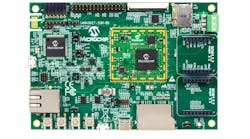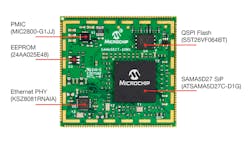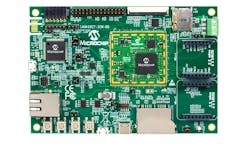Microprocessors continue to push the power and performance envelopes, but they lack the integration of microcontrollers that typically provide single-chip solutions that are easy to design into products. Microprocessors need additional memory, power management, and peripheral support, making a designer’s job more difficult.
One solution is to utilize system-on-modules (SOM). SOMs are essentially small printed circuit boards (PCBs) that can be mounted directly onto another PCB. A SOM typically includes the processor, memory, and support chips so that designers need only add connectors and specialized peripheral support on the host PCB. This is where Microchip’s new SAMA5DS27 SOM (Fig. 1) comes into play.
1. Microchip’s SAMA5DS27 SOM has a SAMA5D27 Cortex-A5 with 128 MB of DDR2 memory, 8 MB of QSPI flash memory, 10/100 Ethernet, and PCI level security support.
The SAMA5DS27 SOM is based on the ultra-low-power, 500-MHz SAMA5D27 that contains a 32-bit ARM Cortex-A5 processor. The SOM adds 128 MB of DDR2 DRAM and 8 MB of QSPI flash memory. Additional memory can be connected to the SOM. The processor supports QSPI Execute-in-Place (XIP) Linux.
In addition, a 256-byte EEPROM contains a pre-programmed MAC address for the 10/100 Ethernet interface. An on-board PHY with clock further simplifies network interface design.
The 38- by 40-mm SOM has its own power-management support. This allows it to operate with a single 3.3-V power supply. There are three crystals on-board for timing, so no off-board clock is required. The module has 103 IO pins. IO includes support for 24-bit LCD displays, capacitive touch interface, 12-bit raw Bayer camera interface, and an audio subsystem.
The SAMA5D27 processor includes a secure enclave that has ARM TrustZone support. It can handle on-the-fly encryption and decryption from DDR memory. The system also has either tamper detect pins or secure key storage, and it’s Payment Card Industry (PCI) pre-certified. PCI support allows systems to be used in electronic fund transactions.
The SOM is rated for temperatures of -40 to +85°C. The design files are freely available, enabling developers to transition from the SOM to a dedicated PCB if so desired. Still, many will likely deliver products based on the industrial-grade SOM since it simplifies the host PCB design.
By the way, many developers will appreciate that the SOM can be soldered by hand. This is handy when building prototypes. Numerous variations are available, including a low-end solution that’s in an 11-mm by 11-mm BGA196 package with 16 MB of DRAM. This is designed for bare-metal or compact RTOS-based applications.
2. The SAMA5DS27 SOM is available on Microchip’s evaluation board that includes a wide range of peripheral interfaces from mikroBUS to PMOD.
The SOM is also available on Microchip’s $245 evaluation board (Fig. 2). It has a number of interface connectors including LCD support. There’s a microSD socket for flash memory and an SD card slot that can handle memory or peripherals such as wireless interfaces. Various headers include two mikroBus sockets that support MikroElektronica Click boards as well as a PMOD connector.
The SOM can run Linux. Microchip's Linux4SAM.org site provides examples, and Yocto and Buildroot support for all Microchip SAM platforms. Security support is available through the Sequitur Labs IoT Security Suite. This includes trusted boot support, firmware protection, trusted device IDD, secure storage, security communications using TLS and OpenSSL, plus secure firmware updates.




